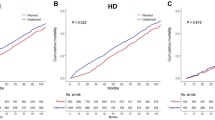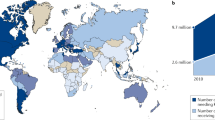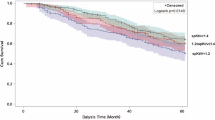Abstract
The duration and frequency of hemodialysis was determined empirically when this therapy first came into use, and treatment was commonly three 8 h sessions per week by the end of the 1960s. Subsequently, however, the growing number of patients who required this therapy had to be reconciled with the shortage of equipment; therefore, dialysis time was decreased to three 4 h sessions per week. At the same time, on the basis of data from the first randomized controlled trial of dialysis—the National Cooperative Dialysis Study—Kt/Vurea was devised as the optimum measure of dialysis adequacy. Nowadays, although Kt/Vurea targets are fulfilled in an increasing number of patients, observational studies show that individuals on hemodialysis continue to experience a high rate of complications, including hypertension, left ventricular hypertrophy, cardiac failure, hyperphosphatemia, malnutrition and death. Although no randomized controlled trial has yet been published, observational data indicate that increasing hemodialysis time and/or frequency improves a number of these complications, especially the death rate. This Review outlines the advantages of longer and/or more frequent dialysis sessions and highlights the barriers to adoption of such regimens, which largely relate to economics, patient willingness, and organization of dialysis units.
Key Points
-
Observational data suggest that increasing hemodialysis session time and/or frequency reduces the risk of complications
-
Increasing dialysis session time and/or frequency reduces ultrafiltration rate, which contributes to the improvement of cardiovascular complications by the use of alternative dialysis strategies
-
Phosphate removal is time-dependent, and long dialysis sessions help to achieve phosphate balance and reduce the need for phosphate binders; however, short daily dialysis has limited effect on phosphate control, especially in patients with high protein intake
-
Appetite and nutritional markers are positively influenced by increasing dialysis time or frequency
-
Randomized controlled trials comparing the effects of conventional and short daily or long nocturnal daily hemodialysis on mortality, left ventricular mass and quality of life are underway
-
Nephrologists have the task of convincing both their patients and the managers of their dialysis facility to accept and implement high-frequency and/or prolonged dialysis regimens
This is a preview of subscription content, access via your institution
Access options
Subscribe to this journal
Receive 12 print issues and online access
$209.00 per year
only $17.42 per issue
Buy this article
- Purchase on Springer Link
- Instant access to full article PDF
Prices may be subject to local taxes which are calculated during checkout




Similar content being viewed by others
References
Scribner BH et al. (1960) The treatment of chronic uremia by means of intermittent hemodialysis: a preliminary report. Trans Am Soc Artif Intern Organs 6: 114–122
Thomson GE et al. (1967) Hemodialysis for chronic renal failure: clinical observations. Arch Intern Med 120: 153–167
Curtis JR et al. (1969) Maintenance haemodialysis. Q J Med 38: 49–89
Traeger J et al. (1969) Arterial hypertension in chronic kidney failure treated by extra-renal dialysis [French]. Acquis Med Recent 261–296
Vertes V et al. (1969) Hypertension in end-stage renal disease. N Engl J Med 280: 978–981
Cambi V et al. (1975) Short dialysis schedules (SDS)—finally ready to become routine. Proc Eur Dial Transplant Assoc 11: 112–120
Degoulet P et al. (1982) Mortality risk factors in patients treated by chronic hemodialysis: report of the Diaphane collaborative study. Nephron 31: 103–110
Levey AS et al. (1998) Controlling the epidemic of cardiovascular disease in chronic renal disease: what do we know? What do we need to learn? Where do we go from here? National Kidney Foundation Task Force on Cardiovascular Disease. Am J Kidney Dis 32: 853–906
Lowrie EG et al. (1981) Effect of the hemodialysis prescription of patient morbidity: report from the National Cooperative Dialysis Study. N Engl J Med 305: 1176–1181
[No authors listed] (1997) NKF-DOQI clinical practice guidelines for hemodialysis adequacy: National Kidney Foundation. Am J Kidney Dis 30 (Suppl 2): S15–S66
Tattersall J et al. (2007) EBPG guideline on dialysis strategies. Nephrol Dial Transplant 22 (Suppl 2): ii5–ii21
Gotch F (2007) The basic, quantifiable parameter of dialysis prescription is Kt/V urea; treatment time is determined by the ultrafiltration requirement; all three parameters are of equal importance. Blood Purif 25: 18–26
Twardowski ZJ (2007) Treatment time and ultrafiltration rate are more important in dialysis prescription than small molecule clearance. Blood Purif 25: 90–98
Eknoyan G et al. for the Hemodialysis (HEMO) Study Group (2002) Effect of dialysis dose and membrane flux in maintenance hemodialysis. N Engl J Med 347: 2010–2019
Port FK et al. (2006) Improving outcomes for dialysis patients in the international Dialysis Outcomes and Practice Patterns Study. Clin J Am Soc Nephrol 1: 246–255
Kimmel PL et al. (2000) Interdialytic weight gain and survival in hemodialysis patients: effects of duration of ESRD and diabetes mellitus. Kidney Int 57: 1141–1151
Lopez-Gomez JM et al. (2005) Interdialytic weight gain as a marker of blood pressure, nutrition, and survival in hemodialysis patients. Kidney Int 67 (Suppl S93): S63–S68
Saran R et al. (2006) Longer treatment time and slower ultrafiltration in hemodialysis: associations with reduced mortality in the DOPPS. Kidney Int 69: 1222–1228
Movilli E et al. (2007) Association between high ultrafiltration rates and mortality in uraemic patients on regular haemodialysis: a 5-year prospective observational multicentre study. Nephrol Dial Transplant 22: 3547–3552
Shoji T et al. (2004) Hemodialysis-associated hypotension as an independent risk factor for two-year mortality in hemodialysis patients. Kidney Int 66: 1212–1220
Duman D et al. (2008) Dialysis-induced hypotension is associated with impaired aortic elasticity in patients undergoing chronic hemodialysis. Blood Press Monit 13: 73–78
Charra B (1994) Control of blood pressure in long slow hemodialysis. Blood Purif 12: 252–258
Charra B et al. (1992) Survival as an index of adequacy of dialysis. Kidney Int 41: 1286–1291
Fagugli RM et al. (2003) Association between extracellular water, left ventricular mass and hypertension in haemodialysis patients. Nephrol Dial Transplant 18: 2332–2338
Goodkin DA et al. (2004) Mortality among hemodialysis patients in Europe, Japan, and the United States: case-mix effects. Am J Kidney Dis 44 (Suppl 2): S16–S21
Goodkin DA et al. (2003) Association of comorbid conditions and mortality in hemodialysis patients in Europe, Japan, and the United States: the Dialysis Outcomes and Practice Patterns Study (DOPPS). J Am Soc Nephrol 14: 3270–3277
Toz H et al. (2007) Improvement in “uremic” cardiomyopathy by persistent ultrafiltration. Hemodial Int 11: 46–50
Brunet P et al. (1996) Tolerance of haemodialysis: a randomized cross-over trial of 5-h versus 4-h treatment time. Nephrol Dial Transplant 11: 46–51
Laurent G and Charra B (1998) The results of an 8 h thrice weekly haemodialysis schedule. Nephrol Dial Transplant 13: 125–131
Okada K et al. (2005) Prolonged protective effect of short daily hemodialysis against dialysis-induced hypotension. Kidney Blood Press Res 28: 68–76
Chan CT et al. (2003) Short-term blood pressure, noradrenergic, and vascular effects of nocturnal home hemodialysis. Hypertension 42: 925–931
Chazot C et al. (1995) Interdialysis blood pressure control by long haemodialysis sessions. Nephrol Dial Transplant 10: 831–837
Culleton BF et al. (2007) Effect of frequent nocturnal hemodialysis vs conventional hemodialysis on left ventricular mass and quality of life: a randomized controlled trial. JAMA 298: 1291–1299
Fagugli RM et al. (2006) Effects of short daily hemodialysis and extended standard hemodialysis on blood pressure and cardiac hypertrophy: a comparative study. J Nephrol 19: 77–83
Fagugli RM et al. (2001) Short daily hemodialysis: blood pressure control and left ventricular mass reduction in hypertensive hemodialysis patients. Am J Kidney Dis 38: 371–376
Chan CT et al. (2002) Regression of left ventricular hypertrophy after conversion to nocturnal hemodialysis. Kidney Int 61: 2235–2239
Katzarski KS et al. (1999) Fluid state and blood pressure control in patients treated with long and short haemodialysis. Nephrol Dial Transplant 14: 369–375
Chan CT et al. (2004) Impact of nocturnal hemodialysis on the variability of heart rate and duration of hypoxemia during sleep. Kidney Int 65: 661–665
Chazot C et al. (1999) The Janus-faced aspect of 'dry weight'. Nephrol Dial Transplant 14: 121–124
Chan C et al. (2002) Improvement in ejection fraction by nocturnal haemodialysis in end-stage renal failure patients with coexisting heart failure. Nephrol Dial Transplant 17: 1518–1521
Luik AJ et al. (2001) The influence of increasing dialysis treatment time and reducing dry weight on blood pressure control in hemodialysis patients: a prospective study. Am J Nephrol 21: 471–478
Chan CT et al. (2005) Dissociation between the short-term effects of nocturnal hemodialysis on endothelium dependent vasodilation and plasma ADMA. Arterioscler Thromb Vasc Biol 25: 2685–2686
Suri RS et al. for the Frequent Hemodialysis Network Trial Group (2007) Frequent Hemodialysis Network (FHN) randomized trials: study design. Kidney Int 71: 349–359
Block GA et al. (1998) Association of serum phosphorus and calcium x phosphate product with mortality risk in chronic hemodialysis patients: a national study. Am J Kidney Dis 31: 607–617
Giachelli CM (2003) Vascular calcification: in vitro evidence for the role of inorganic phosphate. J Am Soc Nephrol 14 (Suppl 4): S300–S304
Ganesh SK et al. (2001) Association of elevated serum PO(4), Ca x PO(4) product, and parathyroid hormone with cardiac mortality risk in chronic hemodialysis patients. J Am Soc Nephrol 12: 2131–2138
Kalantar-Zadeh K et al. (2006) Survival predictability of time-varying indicators of bone disease in maintenance hemodialysis patients. Kidney Int 70: 771–780
Fouque D et al. (2007) EBPG guideline on nutrition. Nephrol Dial Transplant 22 (Suppl 2): Sii45–Sii87
Gutzwiller JP et al. (2002) Estimating phosphate removal in haemodialysis: an additional tool to quantify dialysis dose. Nephrol Dial Transplant 17: 1037–1044
Eloot S et al. (2008) Impact of hemodialysis duration on the removal of uremic retention solutes. Kidney Int 73: 765–770
Gotch FA and Levin NW (2003) Daily dialysis: the long and the short of it. Blood Purif 21: 271–281
Lindsay RM et al. (2003) Calcium and phosphate balance with quotidian hemodialysis. Am J Kidney Dis 42: 24–29
Gotch FA et al. (2003) A kinetic model of inorganic phosphorus mass balance in hemodialysis therapy. Blood Purif 21: 51–57
Kumar VA et al. (2007) Daily home hemodialysis at a health maintenance organization: three-year experience. Hemodial Int 11: 225–230
Ayus JC et al. (2007) Phosphorus balance and mineral metabolism with 3 h daily hemodialysis. Kidney Int 71: 336–342
Rocco MV et al. (2004) The effect of dialysis dose and membrane flux on nutritional parameters in hemodialysis patients: results of the HEMO Study. Kidney Int 65: 2321–2334
Aparicio M et al. (1999) Nutritional status of haemodialysis patients: a French national cooperative study: French Study Group for Nutrition in Dialysis. Nephrol Dial Transplant 14: 1679–1686
Alloatti S et al. (2002) Long nocturnal dialysis. Blood Purif 20: 525–530
Charra B et al. (1998) Hemodialysis trends in time, 1989 to 1998, independent of dose and outcome. Am J Kidney Dis 32 (Suppl 4): S63–S70
Chazot C et al. (2006) Stability of nutritional parameters during a 5-year follow-up in patients treated with sequential long-hour hemodialysis. Hemodial Int 10: 389–393
Galland R et al. (2001) Short daily hemodialysis rapidly improves nutritional status in hemodialysis patients. Kidney Int 60: 1555–1560
Raj DS et al. (2000) Plasma amino acid profile on nocturnal hemodialysis. Blood Purif 18: 97–102
Spanner E et al. (2003) The impact of quotidian hemodialysis on nutrition. Am J Kidney Dis 42: 30–35
Kopple JD et al. (2000) Relationship between nutritional status and the glomerular filtration rate: results from the MDRD study. Kidney Int 57: 1688–1703
Bergstrom J (1996) Anorexia in dialysis patients. Semin Nephrol 16: 222–229
Lopes AA et al. (2007) Lack of appetite in haemodialysis patients—associations with patient characteristics, indicators of nutritional status and outcomes in the international DOPPS. Nephrol Dial Transplant 22: 3538–3546
Goldfarb-Rumyantzev AS et al. (2002) Computer simulation of small-solute and middle-molecule removal during short daily and long thrice-weekly hemodialysis. Am J Kidney Dis 40: 1211–1218
Charra B et al. (2004) Long thrice weekly hemodialysis: the Tassin experience. Int J Artif Organs 27: 265–283
Held PJ et al. (1991) Mortality and duration of hemodialysis treatment. JAMA 265: 871–875
Marshall MR et al. (2006) Associations of hemodialysis dose and session length with mortality risk in Australian and New Zealand patients. Kidney Int 69: 1229–1236
Shinzato T et al. (1997) Survival in long-term haemodialysis patients: results from the annual survey of the Japanese Society for Dialysis Therapy. Nephrol Dial Transplant 12: 884–888
Walsh M et al. (2005) A systematic review of the effect of nocturnal hemodialysis on blood pressure, left ventricular hypertrophy, anemia, mineral metabolism, and health-related quality of life. Kidney Int 67: 1500–1508
Kjellstrand CM et al. (2008) Short daily haemodialysis: survival in 415 patients treated for 1006 patient-years. Nephrol Dial Transplant 23: 3283–3289
Pierratos A (2004) Daily nocturnal home hemodialysis. Kidney Int 65: 1975–1986
Punal J et al. (2008) Clinical effectiveness and quality of life of conventional haemodialysis versus short daily haemodialysis: a systematic review. Nephrol Dial Transplant 23: 2634–2646
Kurella M et al. (2005) Frequent hemodialysis and psychosocial function. Semin Dial 18: 132–136
Kutner NG (2004) Quality of life and daily hemodialysis. Semin Dial 17: 92–98
Barua M et al. (2008) Successful pregnancies on nocturnal home hemodialysis. Clin J Am Soc Nephrol 3: 392–396
Chou CY et al. (2008) Pregnancy in patients on chronic dialysis: a single center experience and combined analysis of reported results. Eur J Obstet Gynecol Reprod Biol 136: 165–170
Halpern SD et al. (2004) Willingness of patients to switch from conventional to daily hemodialysis: looking before we leap. Am J Med 116: 606–612
Goldfarb-Rumyantzev AS et al. (2006) A crossover study of short daily haemodialysis. Nephrol Dial Transplant 21: 166–175
Mohr PE (2001) The economics of daily dialysis. Adv Ren Replace Ther 8: 273–279
Davenport A et al. (2008) Achieving blood pressure targets during dialysis improves control but increases intradialytic hypotension. Kidney Int 73: 759–764
Gunal AI et al. (2002) Paradoxical rise in blood pressure during ultrafiltration is caused by increased cardiac output. J Nephrol 15: 42–47
Ayus JC et al. (2005) Effects of short daily versus conventional hemodialysis on left ventricular hypertrophy and inflammatory markers: a prospective, controlled study. J Am Soc Nephrol 16: 2778–2788
Nesrallah G et al. (2003) Volume control and blood pressure management in patients undergoing quotidian hemodialysis. Am J Kidney Dis 42: 13–17
Zilch O et al. (2007) Sympathetic hyperactivity in haemodialysis patients is reduced by short daily haemodialysis. J Hypertens 25: 1285–1289
Pierratos A et al. (2006) Daily hemodialysis 2006: state of the art [Italian]. Minerva Urol Nefro 58: 99–115
Acknowledgements
The authors thank Chloë Harman, Locum Editor of Nature Clinical Practice Nephrology, for her editorial help. The authors are also deeply appreciative to the scientific committee of Photo-Graph® for authorizing the use of its mineral metabolism data. Désirée Lie, University of California, Irvine, CA, is the author of and is solely responsible for the content of the learning objectives, questions and answers of the Medscape-accredited continuing medical education activity associated with this article.
Author information
Authors and Affiliations
Corresponding author
Ethics declarations
Competing interests
The authors have served as consultants for Fresenius Medical Care.
Rights and permissions
About this article
Cite this article
Chazot, C., Jean, G. The advantages and challenges of increasing the duration and frequency of maintenance dialysis sessions. Nat Rev Nephrol 5, 34–44 (2009). https://doi.org/10.1038/ncpneph0979
Received:
Accepted:
Published:
Issue Date:
DOI: https://doi.org/10.1038/ncpneph0979
This article is cited by
-
Antihypertensive Therapie bei CKD-Stadium 5
Die Nephrologie (2022)
-
Non-medical facilitators and barriers towards accessing haemodialysis services: an exploration of ethical challenges
BMC Nephrology (2018)
-
Is it useful to increase dialysate flow rate to improve the delivered Kt?
BMC Nephrology (2015)
-
Pro and con arguments in using alternative dialysis regimens in the frail and elderly patients
International Urology and Nephrology (2015)



